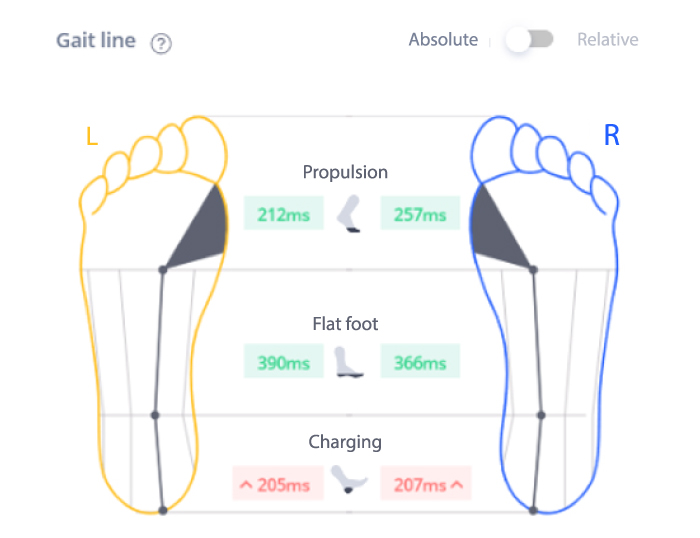Gonarthrosis
Gait line
Pronation / supination angles
Opening angle, Swing
Steppage, Clearance
What information was collected during the clinical examination?
During the clinical examination, the right knee was not swollen and there was no pain upon manipulation.
He quantifies his pain today at 5/10 and maybe more during long runs. He wishes to continue running and is aware that continuing an intense activity runs the risk of deteriorating the condition of his knee.
In the stationary examination, he had a slight collapse of the midfoot on both sides and instability when standing on one foot.
In the x-ray examination prescribed by his treating physician, the beginning of exterior femoral-tibial arthrosis and femoral-patellar arthrosis is observed.
No abnormal wear in the shoes.
Information collected during the walking and running examination:
Fabrice Millet uses MovScan for the dynamic analysis (walking or running depending on the patient). He collects data on the patient’s walking or running activity using the web interface available online at https://app.digitsolepro.com
The results are then presented to the patient, allowing the patient to integrate them into the treatment process and facilitating acceptance.
The exam was completed using MovScan to determine how the patient compensates for his pain.
Different parameters will be used to complete the clinical examination:
The gait line: shows the roll of the step with regard to forces exerted as well as the contact times for each phase of the step. In this patient we observe a pronator gait line, long contact times for the striking phase, often a sign of compensation.

Pronation/supination angles: in a very precise manner, they show the deviation of the foot when walking. This patient strikes with a slight valgus then returns in the walking corridor (blue zone) with a slight supination (angle of lifting the heel greater than the angle of lifting the toes).
What is also interesting is visualizing the gap between the two extreme tracks (the more spread out they are, the more the patient tends to compensate with time). In this case, he has the tendency to compensate at the time of striking and propulsion. This can be confirmed by the opening of the step.

The opening angle, the swing, the steppage and the clearance: the Fick angle allows us to find the opening of the step when walking (a pronation decreases the Fick angle and inversely for supination). For this patient we realize that he primarily compensates because the Fick angle is small (normally between 9.4 and 15.7°) and larger on the right.
No swing and no anomalies in the height of the toes in relation to the floor.
The steppage, which is the striking angle of the step, is high on the right side (normal at 20°), a sign that the patient is strongly compensating at the moment of the strike.

The walking profile allows us to determine the ratios between contact time, airtime, and support, as well as the length of the stride (distance between two heel contacts on the same side).
With regard to this patient, we mainly note a longer stride on the side experiencing pain (right).
This difference can be explained by the propulsion ratio.

The propulsion ratio allows us to determine the muscle groups utilized, between the hip flexors and the plantar flexors. For this patient, we observe a different utilisation when comparing the two sides. The plantar flexors are more utilized on the right side (painful side), explaining the longer stride.

The running examination with DigitsolePro
Using MovScan, the practitioner will be able to complete the clinical examination and advise the patient on the manner of running that could also be the cause of their pathologies.
The strike type and the overall force of impact: allow us to determine the specific way in which the runner strikes and quantify the strike as well as quantify the impact on the ground.
This patient has a pure heel strike (traumatising strike) and a weak force of impact on the right side, which clearly expresses the extent of the pain.

The running cadence allows us to determine the number of steps per minute, as well as to advise on a cadence that is biomechanically optimal (175-185 steps/minute).
This patient has a slow cadence.

Angles of pronation/supination when running: deviation of the foot when running during the phases of striking, flat foot and propulsion. This patient has a valgus strike, then continues in pronation during the flat foot stage, and propulsion is also in pronation.

What diagnosis and treatment or solution was provided to the patient?
Following the various examinations, it was determined that the patient had a tendency to pronate.
When walking he compensates because he does not feel sufficient support on the inside, and when running the pronation is tangible.
Orthopedic soles will be made for running with the intention of controlling the collapse of the midfoot. They will also be worn when walking.
He will be referred to a physical therapist to see if the reinforcement of internal vastus could be helpful.
A consultation with an orthopedic surgeon will also be recommended.
With regard running, he should speed up his cadence, which could in fact change his striking type, changing to a striking type that is more midfoot. This should be done in a progressive manner to avoid provoking injuries.
Need more information about Digitsole Pro?
Please complete the contact form for all information requests about Digitsole Pro.
Our team will get back to you as soon as possible.
















